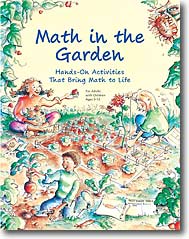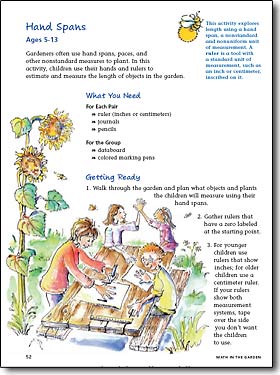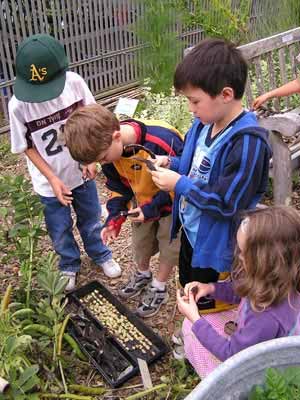UC Berkeley Press Release
UC Botanical Garden designs book to sprout fun ways for kids to learn math outdoors
BERKELEY – President Bush, distressed by American students' poor standing in math proficiency, may be happy to hear about "Math in the Garden," a new book produced by the University of California Botanical Garden and the Lawrence Hall of Science that provides novel, fun techniques to teach and learn mathematical skills and reasoning.
 "I would have given anything to have had something like this when I was a kid," said Katharine Barrett, the UC Botanical Garden's associate director for education and an admitted math-phobic biologist. She still remembers her college calculus class without fondness, but said her attitude toward math completely turned around as a result of working on "Math in the Garden."
"I would have given anything to have had something like this when I was a kid," said Katharine Barrett, the UC Botanical Garden's associate director for education and an admitted math-phobic biologist. She still remembers her college calculus class without fondness, but said her attitude toward math completely turned around as a result of working on "Math in the Garden."
The colorfully illustrated book features 36 informal, hands-on activities that virtually anyone from teachers and scout leaders to home-schoolers and grandparents can try with youngsters in the open air of the garden. The exercises are aimed at children ages 5 through 13 and are closely linked to state and national mathematics standards, Barrett said.
While not a textbook, "Math in the Garden" guides adults step by step with easy-to-follow instructions and simple math background. It also offers certified teachers opportunities to expand on each lesson. Its development was funded by the National Science Foundation.
Jenny White, the "Math in the Garden" project director and retired associate director for education at the Botanical Garden, said the book resulted from researchers' shared vision about the possibilities of taking children out into the garden to discover math.
 Exercises from the book include illustrations, material lists, directions and ideas for further exploration. (Images courtesy UC Botanical Garden) |
Upon arriving at the garden 10 years ago, she said she noticed "how much botany is full of the language of mathematics." The book incorporates the mathematical bits and pieces found in gardens such as patterns, the number of petals, leaf arrangements along a stem, shapes of stems and plant growth rates.
All exercises and suggested follow-up questions have been field tested across the country, including in programs at the Brooklyn Botanic Garden and with teachers in more than 20 San Francisco Bay Area schools, many of them in urban areas. It also was tried out on students enrolled in summer and after-school programs.
"What was amazing was that these kids, who really didn't want to be there, were using math and coordinates to find treasures," Barrett said of the book field testing. "And they were saying, 'Oh, wow. This is what we've been doing in math class.'"
Materials required for the exercises are inexpensive and can be found in most home and garden shops.
The 160-page soft cover book leads adults and youth into the garden to conduct investigations and to estimate and measure growth and harvests. Students can turn an assortment of fresh plants into "data snacks" that teach how to count and analyze, and impart much about geometric shapes and symmetry. They measure crops and plant in circles, make Popsicle stick calipers to measure angles, and transform a plastic clothesline into a mathematical grid.
 By getting kids involved in activities like counting seeds, measuring crops, tasting foods and planting in circles, "Math in the Garden" teaches an appreciation for the outdoors and nutrition in addition to mathematical concepts. |
Students also keep journals to reflect on their garden experiences, Barrett said, noting that journaling is proven to promote learning and help the writers make connections between differing activities.
"These are not 'dressed up' environmental education activities," said White. "They are first and foremost mathematics activities that use plants and garden activities as manipulatives."
Some schools that have tested the "Math in the Garden" curriculum also are using it to improve language skills and to teach nutrition and fitness, said Barrett, noting that working in the garden can actually match the physical exertion of working out in a gym. The Hayward Unified School District has adopted "Math in the Garden" as part of its nutrition curriculum.
The book is published by the non-profit National Gardening Association (NGA). It sells for $29.95 and is available at the UC Botanical Garden shop at 200 Centennial Drive in Berkeley. More information is available on the garden's Web site at: http://botanicalgarden.berkeley.edu/. The book also can be purchased through the NGA's online store at: http://www.kidsgardeningstore.com/ or its Gardening with Kids catalog.

